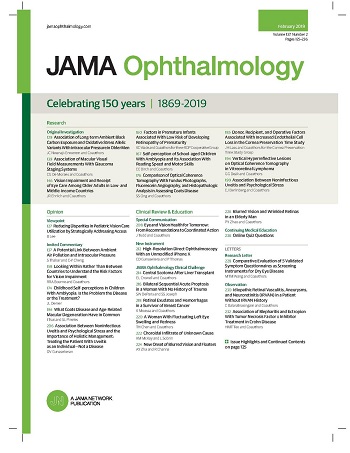Smooth Pursuit Velocity After a Season of Repetitive Head Impacts in American Football Players.
IF 9.2
1区 医学
Q1 OPHTHALMOLOGY
引用次数: 0
Abstract
Importance Repetitive head impacts (RHI) are blows to the head that do not elicit clinical signs or concussion symptoms. Yet, research suggests that brain integrity and functionality can be altered following a single season of contact collision sports. These deficits are untraceable by current clinical testing. Objective To examine the association between RHI and oculomotor control across a single division I American football season. Design, Setting, and Participants This single-center cohort study took place from July 2020 to May 2022. Data were analyzed from May 2022 to December 2024. Participants included 25 division I football players (11 high-dose and 14 low-dose; mean age, 20 [SD, 3] years) and 10 controls (mean age, 22 [SD, 1] years). High-dose and low-dose groups were determined by the head impacts incurred during the season using instrumented mouthguards. Exposure A single competitive season of contact sports. Main Outcomes/Measures All football players wore instrumented mouthguards throughout the 2 seasons (2021 to 2022). Each season was treated as an independent observation with no individual football players included in more than 1 season. A random sample of head impacts across the season were video verified. All participants completed an eye tracking task that consisted of following a Landolt-C moving horizontally during fast (90° per second) and slow (30° per second) conditions at preseason (PRE), midseason (MID), and postseason (POST). Smooth pursuit eye movement velocity was calculated and analyzed. Results A total of 25 male division I American football student-athletes (RHI group; mean age, 20 [SD, 3] years; mean height, 185.72 [SD, 7.40] cm; mean weight, 104.02 [SD, 15.69] kg) and 10 healthy noncontact controls (7 recreationally active [4 female, 3 males] and 3 noncontact National Collegiate Athletic Association swimmers [all female]; mean age, 22 [SD, 1] years) participated in this cohort study. During the season, smooth pursuit eye movement velocity was PRE, 10.01 (SD, 3.16)° per second; MID, 11.48 (SD, 6.57)° per second; and POST, 11.10 (SD, 8.65)° per second for the high-dose group, while the low-dose group was PRE, 11.28 (SD, 4.10)° per second; MID, 11.50 (SD, 5.86)° per second; and POST, 15.02 (SD, 8.26)° per second, with the controls being PRE, 15.60 (SD, 4.44)° per second; MID, 17.95 (SD, 3.73)° per second, and POST, 13.44 (SD, 8.54)° per second. Specifically, at PRE, RHI high-dose players had slower smooth pursuit eye movement velocity compared with controls (difference, 4.28; 95% CI, 2.68-5.81; P = .01). At MID, both high-dose (difference, 8.49; 95% CI, 5.18-11.81; P = .01) and low-dose (difference, 9.15; 95% CI, 6.42-11.87; P = .02) groups had slower smooth pursuit eye movement velocities than controls. Conclusions and Relevance In this study, smooth pursuit eye movement velocity was not affected during a single season of contact sports. Group differences suggest existing deficits before the season begins, possibly due to prior contact sport history. Interpretations should be tempered by the small sample size, single institution used for data collection, and the exploratory nature of the study.美国橄榄球运动员在一个赛季的重复头部撞击后的平滑追求速度。
重要性重复性头部撞击(RHI)是对头部的撞击,不会引起临床症状或脑震荡症状。然而,研究表明,大脑的完整性和功能可以在一个赛季的接触碰撞运动后改变。目前的临床试验无法追踪这些缺陷。目的探讨在一个美国甲级橄榄球赛季中RHI与动眼肌控制之间的关系。设计、环境和参与者本单中心队列研究于2020年7月至2022年5月进行。数据分析时间为2022年5月至2024年12月。参与者包括25名甲级足球运动员(11名高剂量和14名低剂量,平均年龄20 [SD, 3]岁)和10名对照组(平均年龄22 [SD, 1]岁)。高剂量组和低剂量组是通过使用牙套时头部受到的冲击来确定的。接触性运动的单一竞技赛季。主要结果/措施所有足球运动员在2021年至2022年的两个赛季中都佩戴了器械护齿器。每个赛季都被视为一个独立的观察,不包括超过一个赛季的单个足球运动员。整个赛季的头部撞击随机样本进行了视频验证。所有参与者都完成了一项眼球追踪任务,该任务包括在赛季前(PRE)、赛季中期(MID)和赛季后(POST)的快速(每秒90°)和慢速(每秒30°)条件下跟随兰道夫- c水平移动。计算并分析了平滑追踪眼动速度。结果共有25名男性美式橄榄球学生运动员(RHI组,平均年龄20 [SD, 3]岁,平均身高185.72 [SD, 7.40] cm,平均体重104.02 [SD, 15.69] kg)和10名健康非接触对照组(7名从事娱乐活动的[4女,3男]和3名非接触的美国大学生体育协会游泳运动员[均为女性],平均年龄22 [SD, 1]岁)参与本队列研究。季节期间,平滑追踪眼动速度为PRE, 10.01 (SD, 3.16)°/ s;MID, 11.48 (SD, 6.57)°/ s;POST高剂量组为11.10 (SD, 8.65)°/ s, PRE低剂量组为11.28 (SD, 4.10)°/ s;MID, 11.50 (SD, 5.86)°/ s;POST为15.02 (SD, 8.26)°/ s, PRE为15.60 (SD, 4.44)°/ s;MID为17.95 (SD, 3.73)°/ s, POST为13.44 (SD, 8.54)°/ s。具体来说,在PRE阶段,RHI高剂量参与者的平滑追踪眼动速度比对照组慢(差异为4.28;95% CI, 2.68-5.81; P = 0.01)。在MID,两个高剂量组(差异8.49;95% CI, 5.18-11.81; P =。0.01)和低剂量(差异为9.15;95% CI, 6.42-11.87; P = 0.08)。2)组的眼球运动速度比对照组慢。在本研究中,在单赛季的接触性运动中,平滑追求眼动速度不受影响。小组差异表明在赛季开始前就存在缺陷,可能是由于之前的接触运动历史。由于样本量小,数据收集机构单一,以及研究的探索性,解释应有所缓和。
本文章由计算机程序翻译,如有差异,请以英文原文为准。
求助全文
约1分钟内获得全文
求助全文
来源期刊

JAMA ophthalmology
OPHTHALMOLOGY-
CiteScore
13.20
自引率
3.70%
发文量
340
期刊介绍:
JAMA Ophthalmology, with a rich history of continuous publication since 1869, stands as a distinguished international, peer-reviewed journal dedicated to ophthalmology and visual science. In 2019, the journal proudly commemorated 150 years of uninterrupted service to the field. As a member of the esteemed JAMA Network, a consortium renowned for its peer-reviewed general medical and specialty publications, JAMA Ophthalmology upholds the highest standards of excellence in disseminating cutting-edge research and insights. Join us in celebrating our legacy and advancing the frontiers of ophthalmology and visual science.
 求助内容:
求助内容: 应助结果提醒方式:
应助结果提醒方式:


